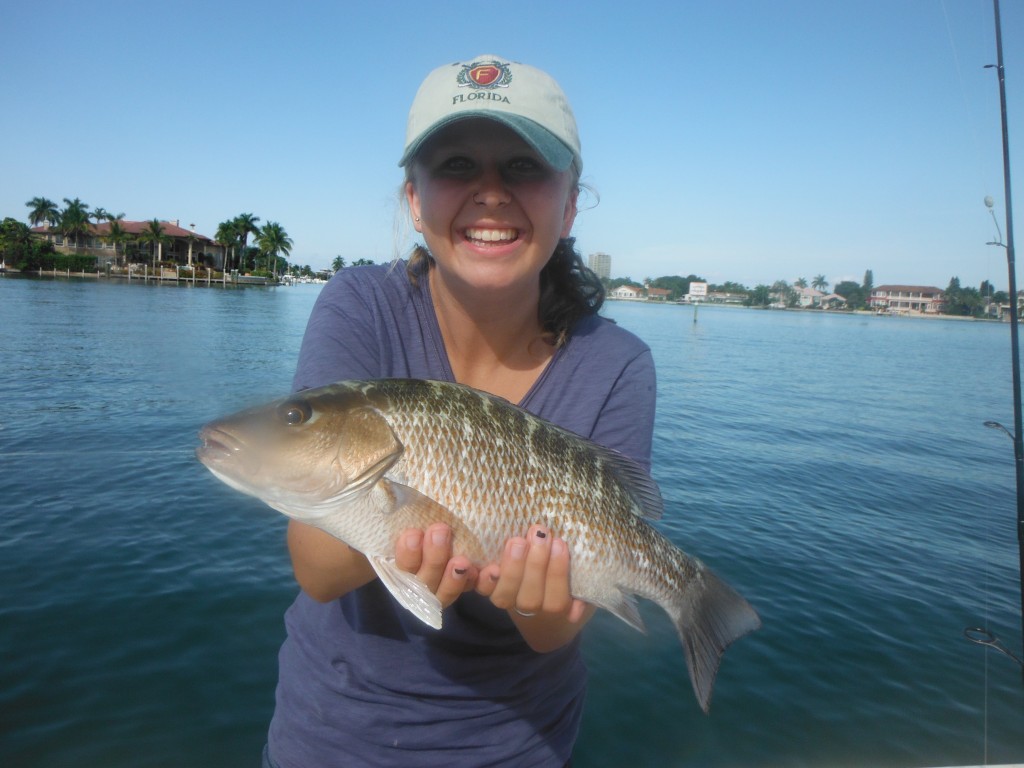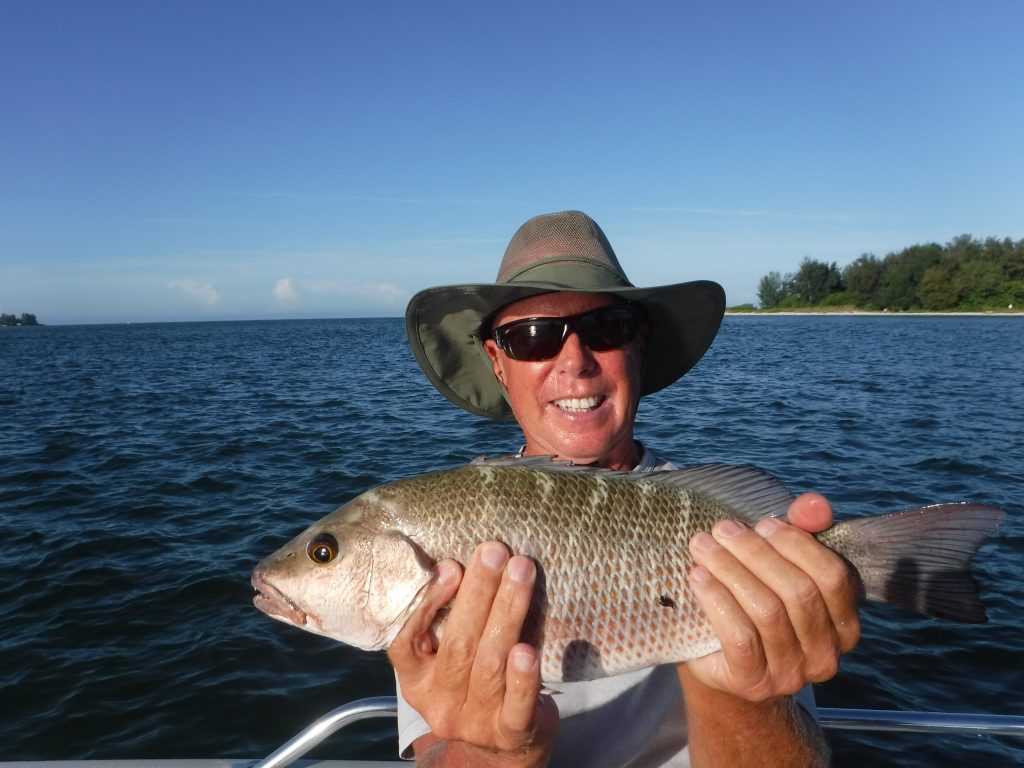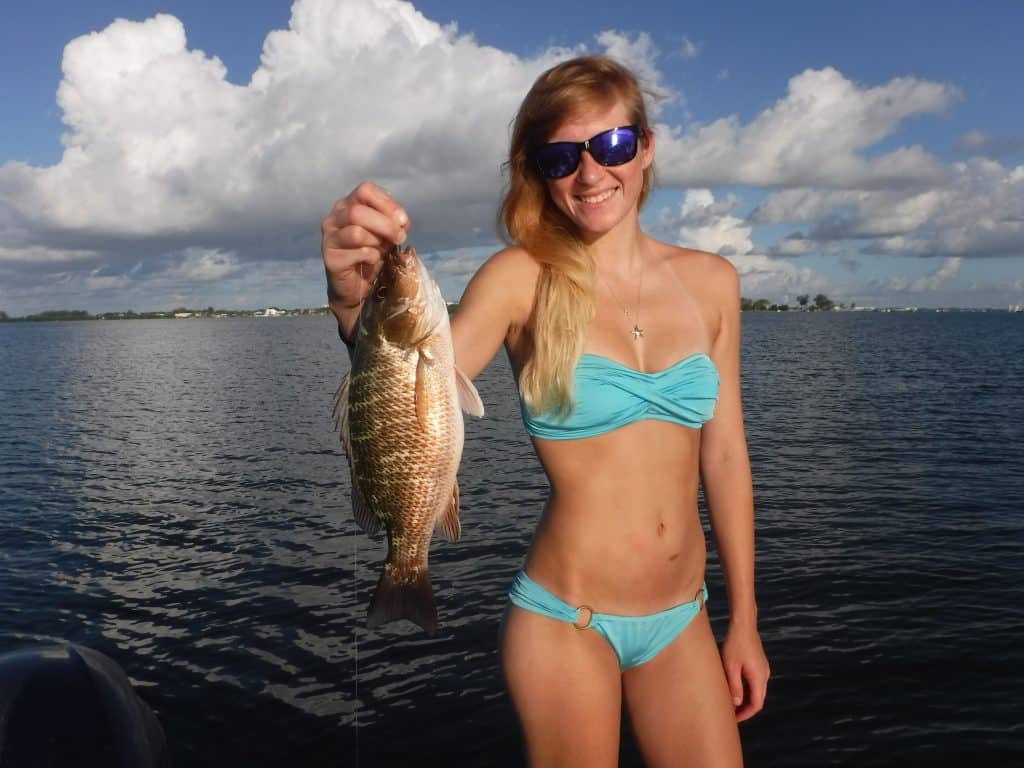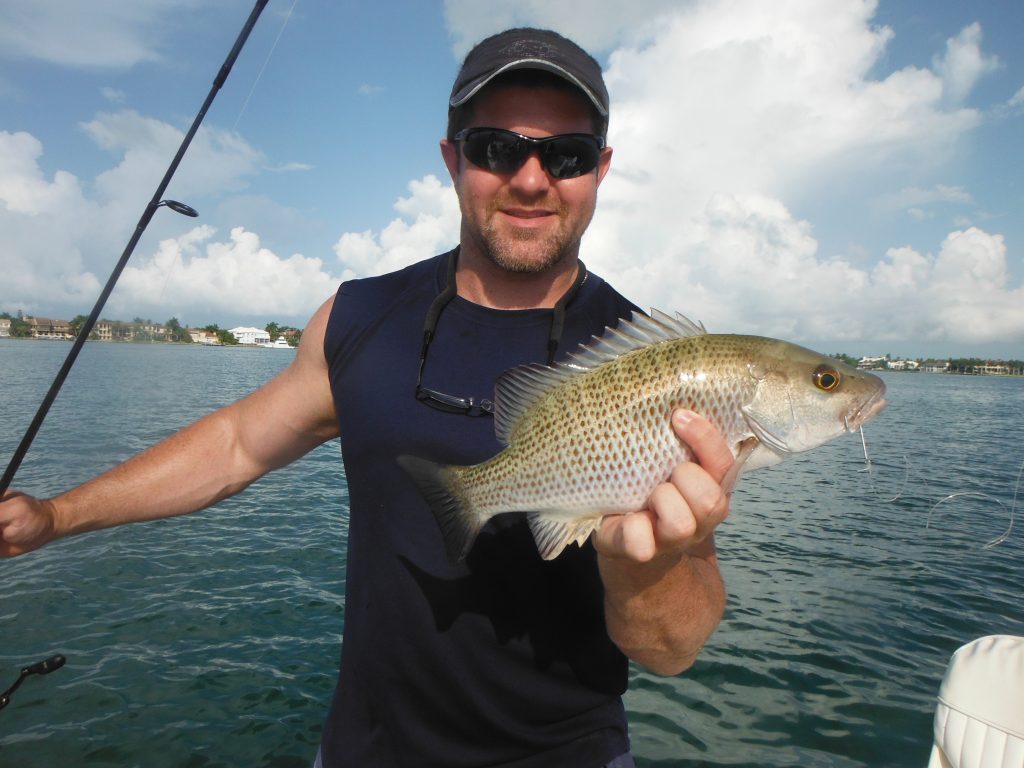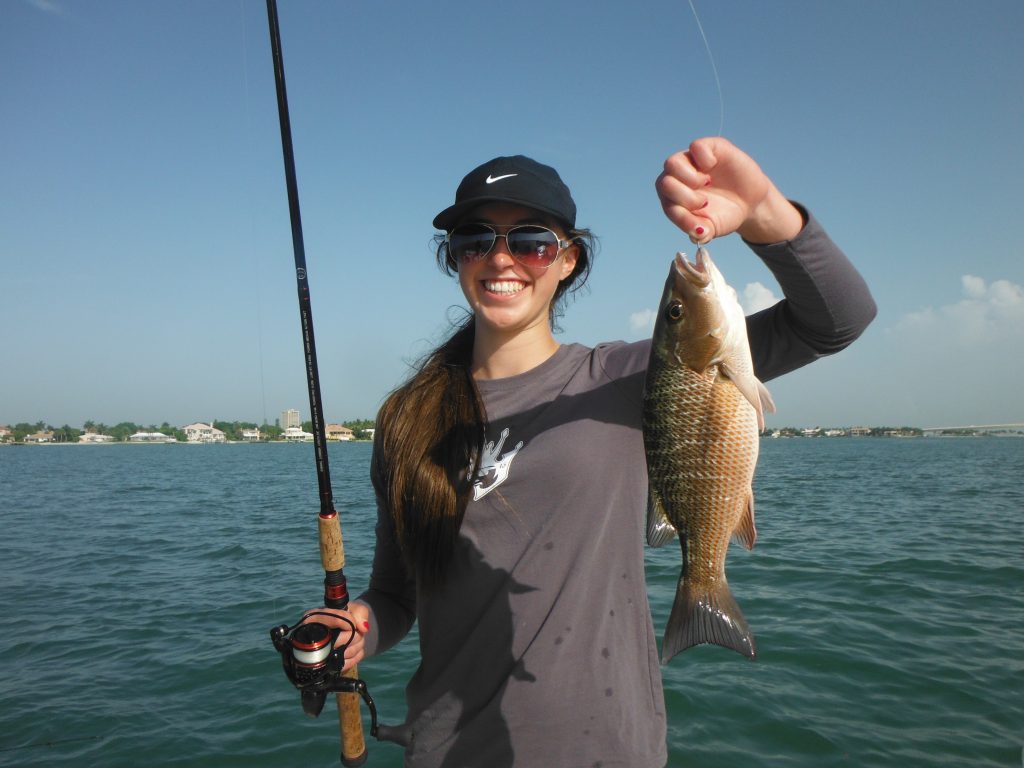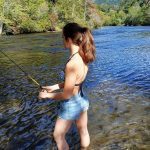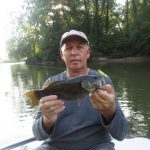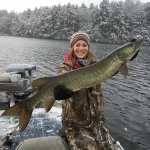Mangrove Snapper Fishing in Florida, a Complete Guide
Many anglers enjoy mangrove snapper fishing in Florida. They are a feisty little game fish on light tackle. Mangrove snapper average a foot or so inshore, but grow to over ten pounds well offshore.
Mangrove snapper are a very popular and highly desired fish species. They put up a great fight, especially on light tackle. Mangrove snapper are abundant and found throughout the entire state of Florida. Large boats and fancy equipment are not required to catch them. Finally, they are terrific eating! Many anglers consider mangrove snapper the finest eating fish and saltwater. They are also known as gray snapper.
One of the keys to the popularity of mangrove snapper is their availability. Mangrove snapper are found in just about every saltwater environment along the entire coast line of the state. Snapper will be caught on the flats along mangrove shorelines, bars, and over grass flats. Structure such as bridges, docks, seawalls, artificial reefs, and natural rock ledges will also hold plenty of these tasty saltwater pan fish. Anglers can find current Florida snapper fishing Regulations on the FWC website.
Top Florida mangrove snapper baits
While mangrove snapper can be taken on artificial lures, the vast majority of fish are caught by anglers using natural bait, either live, fresh cut, or frozen. The list of baits that are effective for snapper fishing is long. Mangrove snapper have a varied diet, which is one of the keys to their success and abundance. They will feed on just about any type of crustacean or bait fish that they find.
The number one bait for anglers fishing inshore is shrimp. Anglers are successful when pursuing mangrove snapper using both live or frozen shrimp. Depending on the circumstances, both can be equally effective. Live shrimp work best when fishing for snapper on the flats. A naturally swimming shrimp free lined on a hook will seldom be refused. Both live and frozen shrimp works fine when bottom fishing around structure.
More mangrove snapper baits
Live bait fish are also a very effective bait and often times will catch larger fish. Small shiny fish such as scaled sardines, Spanish sardines, and threadfin herring work very well. Anglers often use these species to chum snapper into range as well. Small pin fish, grunts, and finger mullet will also catch plenty of fish. Larger pin fish and mullet are often too big for most mangrove snapper, which average a foot or so. However, these larger baits can be cut up into strips or chunks and are a top mangrove snapper bait.
Frozen bait is used successfully from mangrove snapper fishing in Florida as well. Top frozen baits include squid, shrimp, mullet, and any other baitfish that is common to the area being fished. Frozen Spanish sardines are the top frozen bait for anglers fishing deeper water offshore. Squid is a very effective inshore mangrove snapper bait. Many anglers find the convenience of using frozen bait to be a big advantage.
Fishing for mangrove snapper with lures
While the vast majority of mangrove snapper are caught by anglers fishing with live or frozen bait, they will take artificial lures. Many an angler casting a shallow diving jerk baits such as a Rapala X-Rap or Yozuri Crystal Minnow for snook and redfish has been surprised by a feisty mangrove snapper which devoured the bait. Small plugs which mimic the size of the available forage such as finger mullet and scaled sardines work best.
Jigs are another lure that will fool the wary mangrove snapper. Inshore anglers do best with soft plastic baits on a light jig head. Scented baits such as the Gulp line of baits are particularly effective. Offshore anglers use heavy bucktail jigs often tipped with bait or special flutter jigs to catch snapper and deep water.
Mangrove snapper fishing in Florida, rigs and tackle
Most anglers mangrove snapper fishing in Florida use tackle that they already have. The same inshore spinning rods that are well suited for speckled trout and redfish will do fine when fishing for snapper. A 6 1/2 foot to 7 foot medium action spinning rod. With a 2500 series reel and spooled up with 10 pound monofilament or braided line works great. The same applies to offshore; medium-sized spinning tackle and light conventional tackle work well in deeper water around heavier structure.
Anglers can shop at Amazon for a Daiwa Black Gold reel and St Croix Triumph 7′ MF rod spinning combo in this link.
“Fishing Lido Key is a participant in the Amazon Associates Program, an affiliate advertising program designed to provide a means for sites to earn advertising fees by advertising and linking to Amazon. As an Amazon Associate I earn from qualifying purchases.”
Check out this article on inshore saltwater fishing in Florida
When it comes to terminal gear when mangrove snapper fishing in Florida, less is definitely more. This is especially true when fishing in clear water. A 2 foot fluorocarbon leader is generally used, with 20 pound test being a good place to start. A #1 live bait hook or a #2/0 circle hook will do well in most snapper fishing applications. If the bite is slow or fish are seen that won’t take, anglers will often times have to lighten up the leader and maybe drop down on the hook size.
Florida mangrove snapper rigs
There are several rigs that have proven to be very effective when bottom fishing for mangrove snapper and other species. These include a free line rig, high/low rig, Carolina rig, and knocker rig. These four rigs will cover just about every snapper fishing situation and each has its conditions where it performs well.
Free line rig
The free line rig is the most simple and basic of all rigs. It basically consists of a hook that is tied onto the end of the leader. The hook is then baited with a live or cut bait and then cast or free lined back out behind the boat towards the structure. A split shot or two may be required if current is present to get the bait down into the strike zone. This is a very effective rig when fishing structure and flats in shallow water.
High/low rig
The high/low or “chicken rig” as it is known by some locals is an excellent choice when bottom fishing for mangrove snapper using a vertical presentation. The multiple hook suspend the bait at several different depths. This can help determine which depth the fish are feeding at. It works well when fishing from an anchored or drifting boat as well as from peers and bridges.
Carolina rig
The Carolina rig, also known as a sliding sinker rig, is an excellent all round choice for just about any snapper fishing application. An egg sinker is threaded onto the running line followed by a swivel. A leader is tied onto the swivel, then the hook is tied onto the other end of the leader.
The beauty of this rig is that the snapper can pick up the bait and move off a bit without feeling any resistance from the weight. Also, while the sinker sits on the bottom, the bait will swing seductively and naturally in the current. This presents a very natural presentation that fish find difficult to resist.
Knocker rig
The knocker rig is similar to the Carolina rig, with one exception. With the knocker rig, the sinker is installed on the leader just above the hook. Then, once the hook is tied onto the leader, the sinker actually rests right on the eye of the hook. This is an excellent choice when fishing rocks and other structure where hangups are common. The sinker will actually slide up the line and then back down, knocking the hook loose.
Another advantage of this rig is that the angler knows when the sinker is on the bottom, the bait is on the bottom as well. There are times when it is desired to keep the bait right on the bottom in a specific spot as opposed to with a Carolina rig, where it is allowed to swing with the current.
Mangrove snapper locations and Techniques
Mangrove snapper can be found in just about any Florida saltwater environment. Anglers will find them in a foot of water on the shallow grass flats as well as out in the open ocean or Gulf of Mexico in very deep water. Structure is the key when it comes to locating mangrove snapper. This structure takes many forms, however.
Snapper on the flats
Mangrove snapper get their name for their affinity for mangrove shorelines. This is a terrific environment which attracts just about every inshore saltwater species, including mangrove snapper. Mangrove roots offer protection and forage. The best sections of a mangrove shoreline to fish are those with slightly deeper water. Even a depth change of a foot or two can make a significant difference in an otherwise very shallow area.
Both sandbars and oyster bars will hold mangrove snapper on the flats as well. In the Florida Keys, these are called “banks” in our prime snapper fishing areas. Once again, slightly deeper water and a depth changes the key. Bars tend to be shallow on one side that drop off sharply on the other. The deeper edge of the bar is generally the spot that will hold fish.
Mangrove snapper will also school up over the open grass flats. Grass is the key to life on the flats in Florida as it holds a wide variety of forage. Mangrove snapper will often find a slightly deeper depression, also known as a pothole, to gang up in and wait in ambush.
Catching mangrove snapper on the flats
Mangrove snapper fishing in Florida is fairly straightforward. For the most part, it consists of positioning the angler, whether in a boat or from land, up current of the structure that is to be fished. Then, the bait is cast or floated back towards the structure with the current. This results in a very lifelike presentation.
In most instances, live bait produces better than frozen bait fishing for snapper on the flats. They can tend to be spooky, especially in clear water. Live shrimp are a top bait, as are small bait fish such as pilchards, sardines, finger mullet, and silver dollar sized pinfish and grunts. However, this does not mean that mangrove snapper cannot be caught using frozen or cut bait on the flats.
Free lining the bait is an excellent option when possible. As in all fishing, the less weight required to get the bait down into the strike zone, the better. Again to stress the point that in shallow, clear water, snapper can be spooky. Lighter leaders, smaller hooks and less weight and terminal tackle will usually result in more success.
Fishing for mangrove snapper in passes and inlets
Passes and inlets are great spots to target mangrove snapper. These areas have good current flow and normally and abundance of structure. This combination results in a hot spot for mangrove snapper and other bottom species.
Most Florida inlets and passes have residential docks which will hold snapper. These can range from being in a couple of feet of water to over 20 feet deep. Bridges are also very good man made structures that hold a lot of fish. Many inlets and passes have long rock jetties as well. These are fish magnets! Mangrove snapper are just one of the many bottom fish that will hold in the structure.
Tips for fishing passes and inlets
Boat positioning is crucial when it comes to fishing for mangrove snapper and passes and inlets. In most instances, anglers are fishing from an anchored boat. Drifting can be effective, however it often results in snagging lines. It is best to fish passes and inlets during periods of low title flow. Fishing can be very difficult and even downright dangerous when the current is running strong. This is particularly true during periods of heavy boat traffic.
The best approach is almost always to anchor up current of the structure to be fished. This is true whether it is a bridge, or pier, dock, submerged a ledge, or a rock jetty. Anglers will need to experiment with the right amount of weight that will be required. Generally speaking, using just enough weight to hold bottom is ideal.
Several rigs can be used when snapper fishing in passes and inlets. If the water is shallow and current is slack, anglers can free line a bait. However, most often the Carolina rig or knocker rig will work best. Just about any bait can be used in the spots to catch fish. Successful anglers bring several baits and experiment to see what the snapper prefer that day.
More inshore snapper fishing spots
Anglers mangrove snapper fishing in Florida will find these tasty and hard fighting fish just about anywhere there is structure. Bridges, seawalls, artificial reefs, submerged rocky ledges, wrecks, docks and piers are some of the more popular places to find mangrove snapper inshore.
Many of the techniques used when fishing passes and inlets relate to fishing inshore structure as well. Current will dictate where on the structure the fish will locate and how the baits should be presented to them. Once again, boat positioning is crucial to success.
Mangrove snapper fishing without a boat
While boats are convenient, many anglers do quite well mangrove snapper fishing in Florida without one. There are countless places were anglers can fish from shore and do well. All that is really required as a little bit of depth in some type of structure. Jetties at inlets and passes usually offer public access to these excellent fishing spots.
Docks are excellent spots as well, as long as the angler has permission to use them. Bridges are another excellent spot to access some good mangrove snapper fishing. However, laws and restrictions vary in safety can be a concern. This is especially true when fishing at night.
Wading the grass flats is also an option when it comes to mangrove snapper fishing without a boat. The best spots are usually where there is a depth change, a pothole, or some type of structure including docks and rocks.
Mangrove snapper fishing offshore
Many anglers mangrove snapper fishing in Florida choose to do so offshore. And for good reason! While inshore snapper fishing offers good action and fun fishing, anglers seeking trophy mangrove snapper will do best to head out to the deeper water. Mangrove snapper are found in the offshore waters of the Atlantic Ocean and Gulf of Mexico on just about every type of structure unimaginable.
Artificial reefs and wrecks are great place for anglers without a set of bottom numbers to begin their mangrove snapper fishing. The spots to get a lot of pressure, however, as the locations are publicly posted. Anglers who go light on the gear will lose some fish to the structure but will also usually catch more fish.
Successful anglers take the time to find their own unique bottom fishing spots. Mangrove snapper relate well to smaller breaks and hard natural bottom. The spots can be a bit more difficult to locate on the bottom machine. However, once some of the spots are located, anglers can have productive snapper fishing spots for many years to come. Once a ledge or area of rocky bottom is located, anglers should search in that general area as often times more of these types of spots can be located.
Snapper movements
Mangrove snapper will also migrate closer to shore and then further offshore, depending on the season and location. If fishing is slow at a proven spot, it is best to change depth when moving to the next spot as opposed to a lateral move to a different spot in the same depth. This will more quickly determine the depth that the fish are holding at that particular day. Generally speaking, the fish move offshore when it is hot or cold and are closer to shore when water temperature is moderate
Just as when fishing inshore, boat positioning is crucial when it comes to bottom fishing offshore. It can also be a bit more complicated in deeper water as wind and tides will affect the position of the boat. Experience is a great teacher! Once again, the general rule is to position the boat up current of the spot to be fished.
Best baits for offshore snapper
While live shrimp can certainly produce for anglers mangrove snapper fishing offshore, bait fish and cut bait are more often used. Larger snapper tend to be caught on live bait fish and chunks of bait. Also, these baits tend to be hardier and stay on the hook longer. Shrimp can attract pesky bait-stealers.
Frozen Spanish sardines are a very popular bait for anglers bottom fishing offshore. Anglers fishing for snapper generally cut a sardine into three or four pieces. However, anglers targeting trophy fish can cut the tail off and lower down a whole sardine. Is important to thaw out frozen sardines and other frozen bait and saltwater. Thawing frozen bait in freshwater will result in the bait getting mushy.
Many anglers catch their bait on the way out to and offshore fishing spot. Live bait often produces best. Tossing a cast net in the shallows and catching several hundred scaled sardines or threadfin herring will give anglers both fishing bait and chum. Ballyhoo can be caught in a cast net as well as with very small hooks. Sibiki rigs are used around channel markers and hard bottom to catch bait fish as well.
Chumming is a productive technique when fishing for mangrove snapper
Chumming is a very productive technique used by many successful mangrove snapper anglers. It can be as simple as dicing up a few shrimp and tossing them out behind the boat to get fish in the mood to feed. Both inshore and offshore anglers use live bait as chum to excite and attract fish. Frozen chum is very popular as well.
Frozen chum is usually in the form of some type of oily fish that is ground up and frozen. It is then placed in a mesh bag and as it thaws the chum is dispersed throughout the area behind the boat. This type of chumming is most often done offshore and is extremely effective in lowering mangrove snapper and other species to the boat.
Inshore and offshore anglers anglers often chum with live bait fish. This is a bit of a specialized technique that requires a cast net, the ability to throw it, and large recirculating live well. However, the effort is often worth it as this is an exceedingly effective technique for mangrove snapper and just about every other saltwater species. Handfuls of live bait fish tossed out behind the boat, often times crippled before hand, will usually draw fish behind the boat if there in the area.
Snapper bite at night!
Fishing for snapper can be extremely effective at night as well. In fact, many experienced anglers schedule their offshore snapper fishing trips during the full moon’s in summer. This results in a very unique type of fishing trip. Along with being quite productive, anglers escape the heat and sun of the midday hours.
Anglers mangrove snapper fishing in Florida in the inshore waters have known for a long time that snapper feed at night. Lighted bridges and docks can be very productive. The same basic boat positioning, rigging, and fishing techniques that apply during the daytime will produce at night as well.
In conclusion, this article on mangrove snapper fishing in Florida will help anglers catch more of these tasty and hard fighting saltwater fish!
